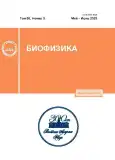The dynamics of biophysical characteristics of the northern Black Sea pelagic ecosystem in the first decades of the XXI century
- Authors: Piontkovski S.A1, Serikova I.M2, Minsky I.M2, Zagorodnyaya Y.A2, Suslin V.V3, Kovaleva I.V2
-
Affiliations:
- Sevastopol State University
- A.O. Kovalevsky Institute of Biology of the Southern Seas, Russian Academy of Sciences
- Marine Hydrophysical Institute, Russian Academy of Sciences
- Issue: Vol 68, No 3 (2023)
- Pages: 564-575
- Section: Articles
- URL: https://journals.rcsi.science/0006-3029/article/view/144458
- DOI: https://doi.org/10.31857/S0006302923030183
- EDN: https://elibrary.ru/FSZQBB
- ID: 144458
Cite item
Full Text
Abstract
Keywords
About the authors
S. A Piontkovski
Sevastopol State University
Email: spiontkovski@mail.ru
Sevastopol, Russia
I. M Serikova
A.O. Kovalevsky Institute of Biology of the Southern Seas, Russian Academy of SciencesSevastopol, Russia
I. M Minsky
A.O. Kovalevsky Institute of Biology of the Southern Seas, Russian Academy of SciencesSevastopol, Russia
Yu. A Zagorodnyaya
A.O. Kovalevsky Institute of Biology of the Southern Seas, Russian Academy of SciencesSevastopol, Russia
V. V Suslin
Marine Hydrophysical Institute, Russian Academy of SciencesSevastopol, Russia
I. V Kovaleva
A.O. Kovalevsky Institute of Biology of the Southern Seas, Russian Academy of SciencesSevastopol, Russia
References
- Основы биологической продуктивности Черного моря (Наукова думка, Киев, 1979).
- EMBLAS. National Pilot Monitoring and Joint Open Sea Surveys in Georgia, Russian Federation and Ukraine, 2016. Final Scientific Report, Ed. by Slobodnik et al. (EU, UNDP, 2017).
- State of the Environment of the Black Sea (2009-2014/5). Publications of the Commission on the Protection of the Black Sea Against Pollution BSC (Istanbul, Turkey 2019).
- T. Oguz, J. W. Dippner, and Z. Kaymaz, J. Marine Systems, 60, 3-4 (2006).
- Ю. В. Артамонов, Е. А. Скрипалева и А. В. Федирко, Метеорология и гидрология, 2 (2017).
- А. А. Кубряков и С. В. Станичный, Океанология, 55, 1 (2015).
- A. V. Kovalev and S. A. Piontkovski, J. Plankton Res., 20, 7 (1988).
- A. Kovalev, U. Niermann, V. Melnikov, et al., in Ecosystem Modeling as a Management Tool for the Black Sea, Ed. by L. I. Ivanov and T.Oguz (Kluwer Acad. Publ., 1998), vol. 1.
- O. A. Yunev, V. I. Vedernikov, O. Basturk, et al., Marine Ecol. Progr. Ser., 230, 11 (2002).
- O. A. Yunev, J. Carstensen, S. Moncheva, et al., Estuarine Coastal and Shelf Science, 74 (2007).
- И. В. Ковалева, З. З. Финенко и В. В. Суслин, Фундаментальная и прикладная гидрофизика, 15, 4 (2022).
- A. Akpinar, E. Sadighrad, B. A. Fach, et al., Remote Sensing, 14 (2022).
- В. Н. Белокопытов, Дис.. д-ра геогр. наук (Морск. гидрофиз. инст., Севастополь, 2017).
- Ю. Н. Токарев, Основы биофизической экологии гидробионтов ("Экоси-Гидрофизика", Севастополь, 2003).
- В. Н. Токарев, П. В. Евстигнеев и О. В. Машукова, Планктонные биолюминесценты мирового океана: видовое разнообразие, характеристики светоизлучения в норме и при антропогенном воздействии (Симферополь, 2016).
- Ковалева, И. В. Интегральная первичная продукция в глубоководных районах Черного моря в 1998 - 2015 годах / И. В. Ковалева, В. В. Суслин // Морской гидрофизический журнал. – 2022. – Т. 38, № 4(226). – С. 432-445. – doi: 10.22449/0233-7584-2022-4-432-445. – EDN MYVMZX.
- V. V. Suslin, and T. Ya. Churilova, Int. J. Remote Sensing, 37, 18 (2016)
- Методика определения качественного и количественного состава зоопланктона (Севастополь, СТП ИМБИ 020-2016, 2016).
- Т. С. Петипа, Труды Севастопольской биологич. станции, 9 (1957)
- Л. Л. Численко Номограммы для определения веса водных организмов по размерам и форме тела (морской мезобентос и планктон) (Наука, Ленинградское отделение, Л., 1968).
- F. Wang, W. Shao, H. Yu, et al., Front. Earth Sci., 8, 14 (2020). doi: 10.3389/feart.2020
- A. G. Barnston and R. E. Livezey, Monthly Weather Rev., 115 (1987).
- В. А. Иванов и В. Н. Белокопытов, Океанография Черного моря (Морской гидрофизический институт, Севастополь, 2011).
- P-M. Poulain, R. Barbanti, S. Motyzhev, et al., Deep-Sea Research I, 52 (2005).
- Э. П. Битюков, П. В. Евстигнеев и Ю. Н. Токарев, Гидробиологич. журн., 29, 4 (1993).
- М. Е. Виноградов и Э. Л. Шушкина, Функционирование планктонных сообществ эпипелагиали океана (Наука, М., 1987).
- Г. В. Зуев и С. А Пионтковский, в сб. Продуктивность экваториальной Атлантики", под ред. Г. В. Зуева (Наукова думка, Киев, 1990).
- A. I. Ginzburg, A. G. Kostianoy, and N. A. Sheremet, J. Marine Systems, 52 (2004).
- T. Oguz, T. Cokacar, P. Malanotte-Rizzoli, et al., Global Biogeochem. Cycles, 17, 3 (2003).
- A. G. Zatsepin, N. N. Golenko, A. O. Korzh, et al., Oceanology, 47 (2007).
- О. А. Юнев, С. К. Коновалов и В. Великова, Антропогенная эвтрофикация в пелагической зоне Черного моря: долговременные тренды, механизмы, последствия (ГЕОС, М., 2019).
- T. Shiganova, E. Musaeva, E. Arashkevich, et al., State of environmental Report 2001-2006/7. Corpus ID: 202591576, Chapter 6. The state of zooplankton. Environmental Science (2012).
- В. С. Латун, в сб.: Устойчивость и эволюция океанологических характеристик экосистемы Черного моря, под ред. В. Н. Еремеева и С. К. Коновалова (Морской гидрофизич. институт, Севастополь, 2012).
- L. Lima, S. A. Ciliberti, A. Aydogdu, et al., Front. Marine Sci., 8, 710973 (2021).
- Масевич, А. В. Динамика содержания кислорода в период дистрофикационных процессов в Черном море / А. В. Масевич, С. К. Коновалов // Морской гидрофизический журнал. – 2022. – Т. 38, № 1(223). – С. 89-104. – doi: 10.22449/0233-7584-2022-1-89-104. – EDN WHFJRJ.
- E. Peneva., E. Stanev, S. Ciliberti, et al., J. Operational Oceanography, 14 (sup. 1) (2021).
Supplementary files










